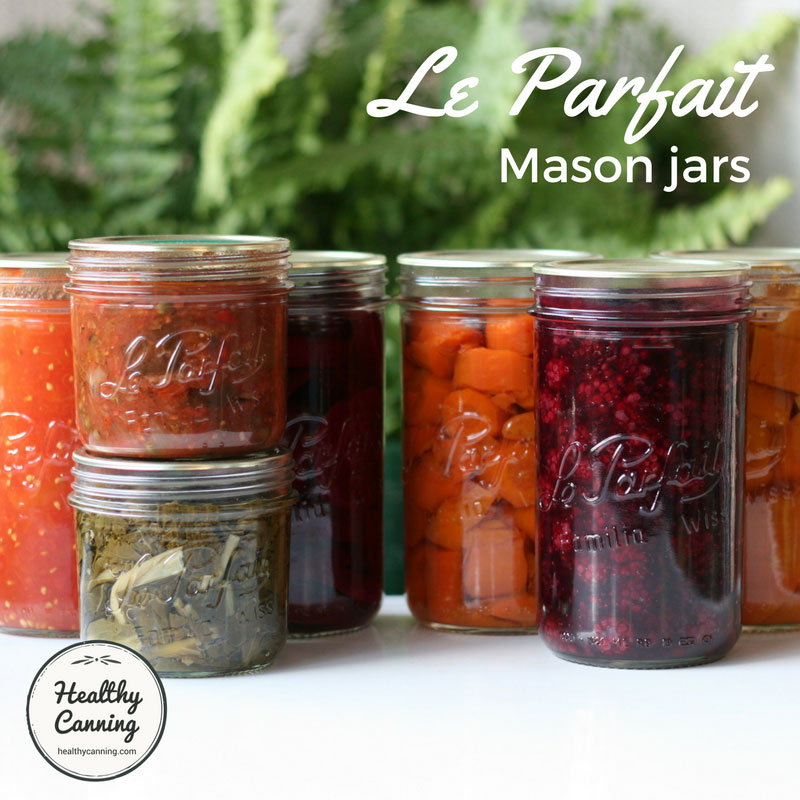
Le Parfait ‘Familia Wiss’ line of Mason jars for home canning
Le Parfait jars are highly desired by cooks the world over. The name means, “The Perfect”.
The company makes a line of wide-mouth, straight-sided Mason-style jars with two-piece lids for home canning. The jars are sold under their “Familia Wiss” brand name, with the coveted “Le Parfait” logo stamped on them.
While pricier than the normal Mason jars that we all buy in bulk, the price point compares to that of other specialty Mason jars now being released by other canning jar companies.
These jars are not new in France, but they will be “new” to North American home canners where promotion of them is starting in earnest.
Disclosure: Le Parfait America approached us, and asked us to work with and review some sample jars, with no strings attached. Our conclusions are documented below and are as rigorously and independently our own as you would expect from Healthy Canning. Any background information provided was verified by research conducted independently by Healthy Canning.
Also on Healthy Canning:
Information about using Le Parfait’s classic hinged-lid (“bail-type”) jars for home food preservation uses other than canning;
A discussion of home canning recipes provided by Le Parfait.
- 1 Familia Wiss jars are two-piece lid Mason jars
- 2 Mouth sizes
- 3 The Familia Wiss jars
- 4 Familia Wiss Lids
- 5 Solid-centre screw bands
- 6 Unique lid stabilizing system during processing
- 7 Opening the lids
- 8 Do the solid screw bands affect jar venting during processing?
- 9 Le Parfait labels
- 10 Production of Le Parfait jars
- 11 History of Le Parfait jars
- 12 Review summary
- 13 Where to buy
Familia Wiss jars are two-piece lid Mason jars
Le Parfait’s “Familia Wiss” jars are essentially standard Mason jars certified by the company for indefinite re-use in home canning. They use a familiar two-piece lid system consisting of a screw band (aka canning ring) and a flat metal lid. The screw band holds the flat lid in place during processing of the jar; the flat lid provides the actual hermetic seal once a vacuum is achieved.
“Familia Wiss” means “Wiss Family.” “Wiss”, pronounced “Viss” in French, comes from “visser”, to screw. “Familia” means “family.”
The flat metal lids will be very familiar to home canners. They are an attractive shiny brass-coloured metal on the top; the coated undersides have a gasket around the rim of them.
There are two things different about Le Parfait’s Mason jars compared to currently well-known brands in North America:
- the jar mouth sizes are different, and
- the screw bands are solid in the centre instead of being open in the middle.
For the lids and screw bands, Le Parfait does use slightly different terminology than you may be used to seeing.
- They call the flat metal lid part variously “sealing cap” (US), “sealing disc” (UK) and “capsule” (French);
- They call the solid-centre screw band variously a “screw lid” and “full lid.”
We’re going to stick with the terms “lid” and “screw band” throughout this page.
Mouth sizes
The Familia Wiss jar mouth sizes of 82mm, 100mm and 110mm are different from the current North American ‘standard’ of 70 mm and 86 mm. (See Lid Sizes.)
This means that only Le Parfait branded replacement lids will work.
On the upside, that also means that the jars have super wide mouths that make the jars easier to pack food into, and easier to clean afterward. It’s hard to emphasize enough what a pleasure it is to work with mouth-sizes this wide.
The Familia Wiss jars
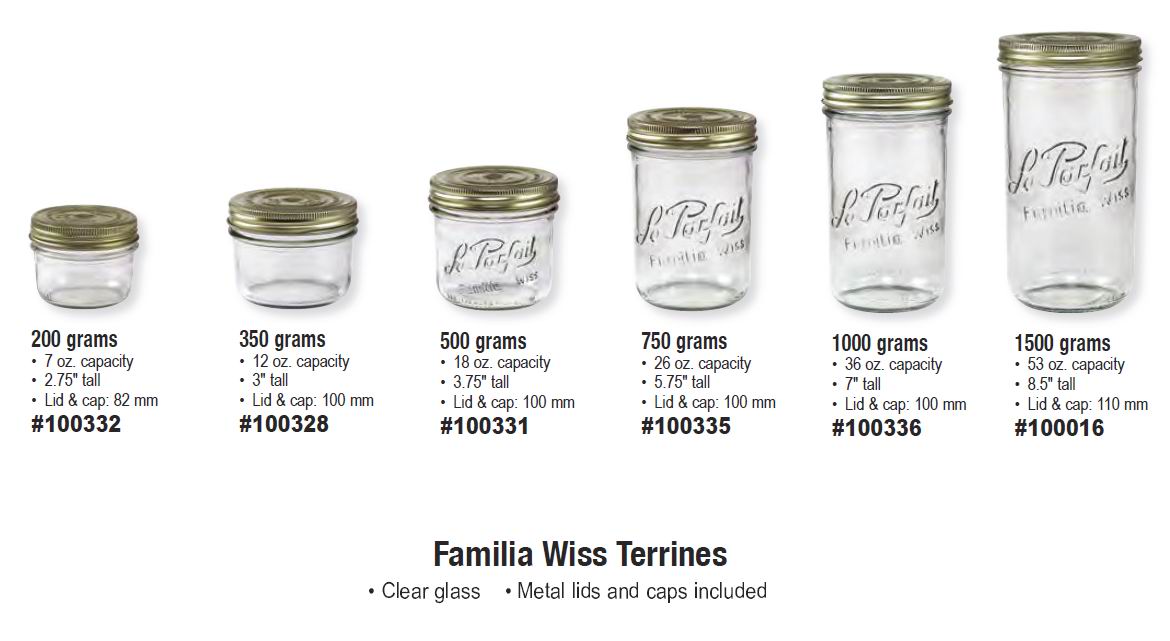
Le Parfait’s size range of its Familia Wiss jars. For grams, read ml. Pictured here with the screw bands on. The real lid is underneath. Courtesy: Bannex International
The Familia Wiss jars are all straight-sided, wide-mouth jars denominated in metric sizes. (For comparison purposes in canning, treat the half-litre (500 ml) size as 1 US pint, the 1 litre (1000 ml) size as 1 US quart.)
They are hefty, weighty-jars made from annealed glass in Puy-Guillaume, Auvergne, France.
The clean sides of the jars make them very easy to label.
Here are photos of the jars in action.
Note: there is also a 350 ml size with a 100 mm mouth, which we did not review.
200 ml jars
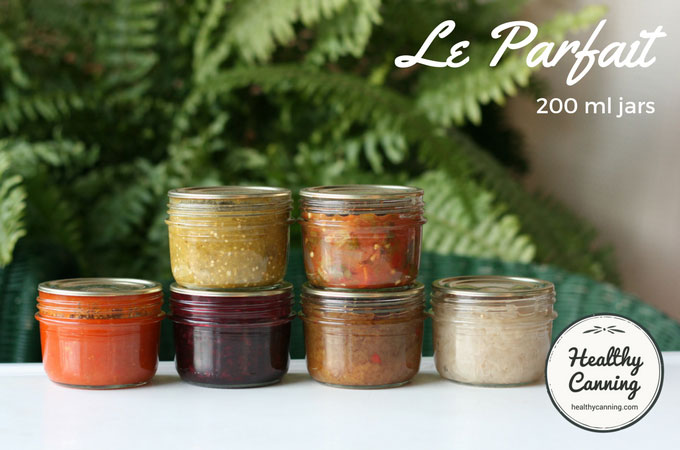
Le Parfait Familia Wiss 200 ml jars (7 oz)
The 200 ml jar is the only one that doesn’t have “Le Parfait” embossed on it. Its mouth size is 82 mm.
500 ml jars
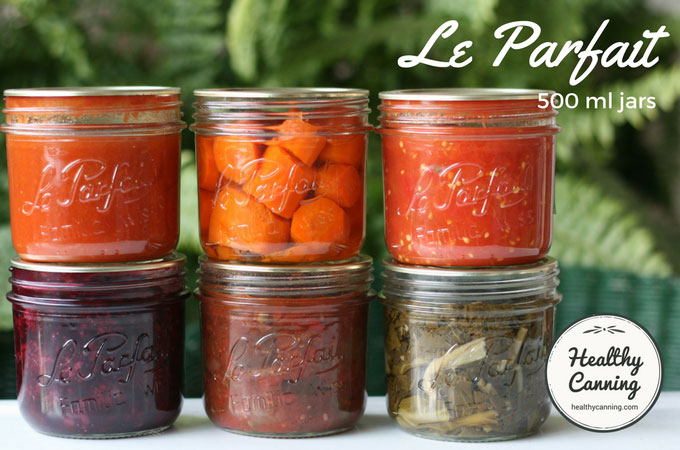
Le Parfait Familia Wiss 500 ml jars (½ litre / 1 US pint)
The mouth size is 100 mm.
750 ml jars
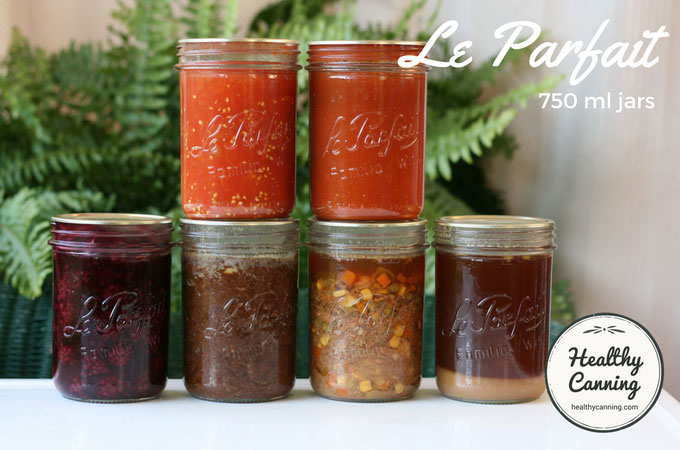
Le Parfait Familia Wiss 750 ml jars (¾ litre / ¾ US quart)
Ideal for two people when a half-litre (US pint) of something might not be enough for two people, but a full litre (US quart) jar would be too much.
Be sure to use processing times for 1 litre / US quart jars when canning with this size of jar.
The mouth size is 100 mm.
1 litre jars
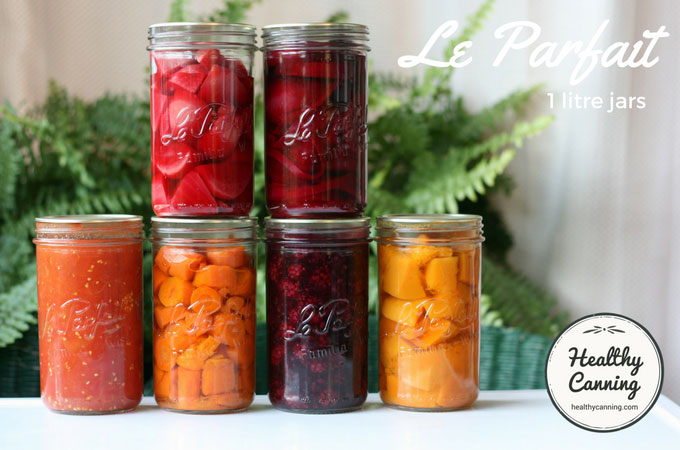
Le Parfait Familia Wiss 1000 ml jars (1 litre / US quart)
The 1 litre (US quart) jar comes with a 100 mm and 110 mm mouth size: we reviewed the 100 mm.
1.5 litre jars
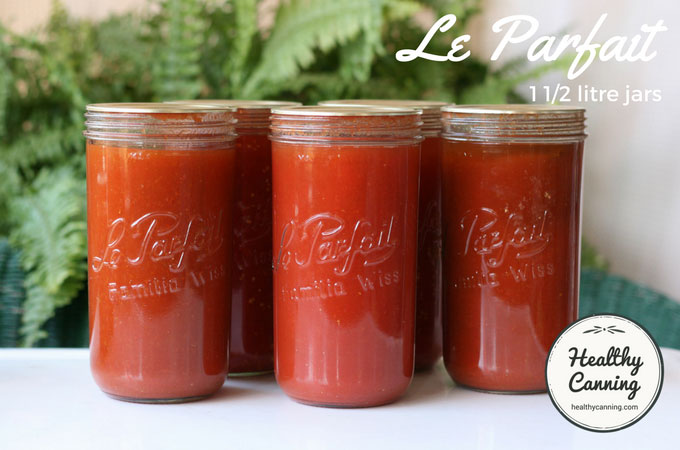
Le Parfait Familia Wiss 1500 ml jars (1.5 litres / US quarts)
The 1.5 litre (US quart) jars can be used for the tomato products in 1.5 litre jars that Ball / Bernardin have tested recipes for. They can also be used for the apple juice and grape juice that the USDA has tested recipes for in 2 litre (quart) jars.
These 1.5 litre (US quart) jars are big jars. Here’s how much liquid they can hold, filled to the “max” fill line that Le Parfait marked on the jar.
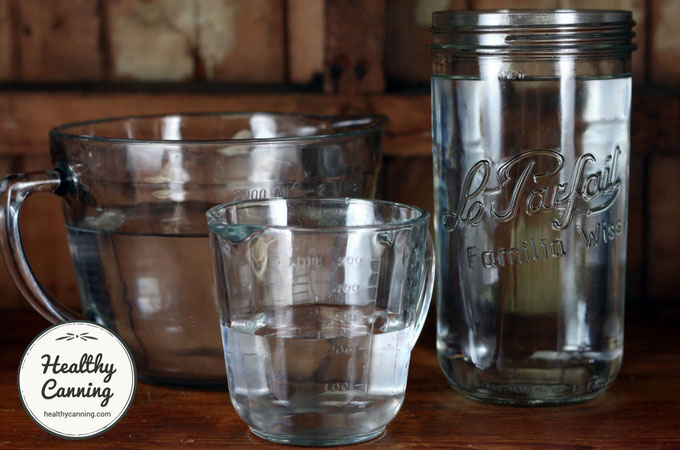
That’s 1 litre (US quart) of water in the big jug, and ½ litre (pint) of water in the smaller jug.
When water-bath canning with them, we were able to fit 4 in a Presto canner used as a water-bather. Pictured is the 16 quart canner so that the camera could see over the rim of the pot. We’d recommend probably the 23 quart canner, to reduce water sloppage on the stove.
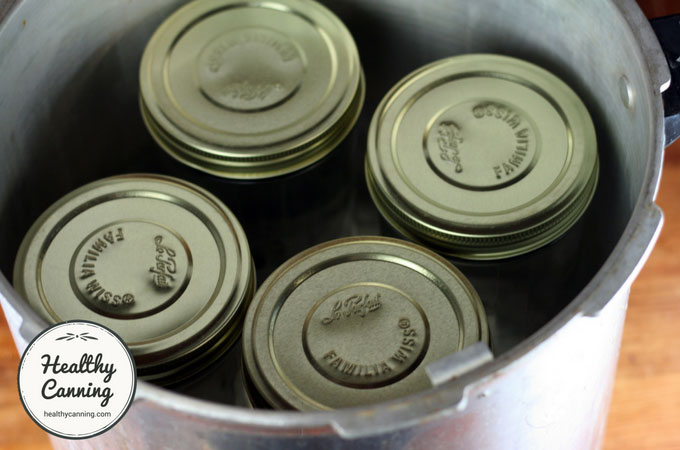
4 will fit in a Presto canner
To re-confirm, there are only tested water-bath recipes for this size of jar and the Presto canners were used in their water-bathing aspect.
If you go by the “max fill line” on the jar, you will end up with 1 ½ inches (3 cm) of headspace in the jars. That’s far too much headspace for the five tested home canning recipes (see above) that are available for this size of jar. Follow the headspace recommendations in those tested recipes instead.
Here’s a final look at just how big these jars are. Here they are compared to a Kerr 1 litre (US quart) jar.
If you are canning tomatoes for a community centre, a crowd of hungry farmhands, etc, imagine how useful this size of jar would be.
The mouth size is 110 mm.
Familia Wiss Lids
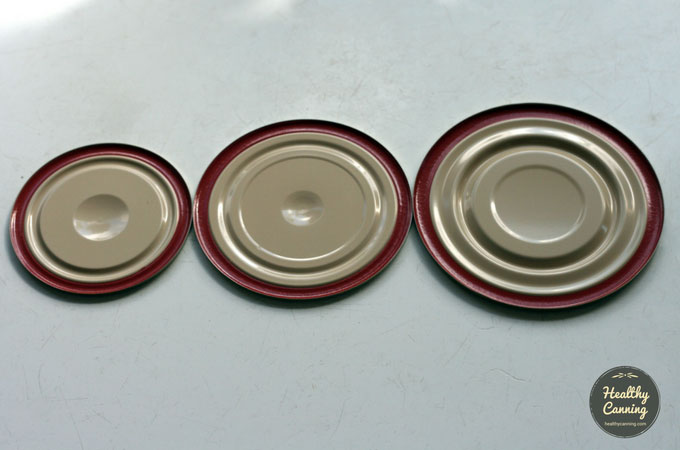
The three different sizes of canning lids (“sealing caps”), showing their coated undersides. Notice two of the lids have centre dimples and the third does not. More on this later.
The lids come in three sizes, to match the three jar mouth sizes. They are made of a thick metal and will be surprisingly heavy for those used to the lighter and thinner metal Mason jar lids currently sold by well-known North American brands.
As the jars cool after processing and the vacuum kicks in sealing the Le Parfait lid, you will hear not just a light “ping” as you do with other Mason jar lids, but instead a very deep, solid “kerplonk.”
The lids are single-use only, like other metal Mason jar lids.
“You must use a new [lid] every time,” they advise. [1] https://www.leparfait.co.uk/le-parfait-familia-wiss-terrines.html. Accessed May 2015
“… the [lids] cannot be reused for heat treatment and must be replaced once the original seal is broken.” [2] Le Parfait Catalogue 2016. Page 13.
You procure the lids by one of two means.
Le Parfait ships each new jar with a lid on it. The lid ships inverted on the jars — that is, with the coated underside and gasket facing up. This sidesteps the whole concern that people have with other lids shipped on jars that arrived with the gaskets already impacted into the rim of the jars. The Le Parfait solution to that issue is brilliantly simple.
After the first use, you get more lids by buying replacing packs.
Like other Mason jar replacement lids, Le Parfait sells its lids in packages of twelve.
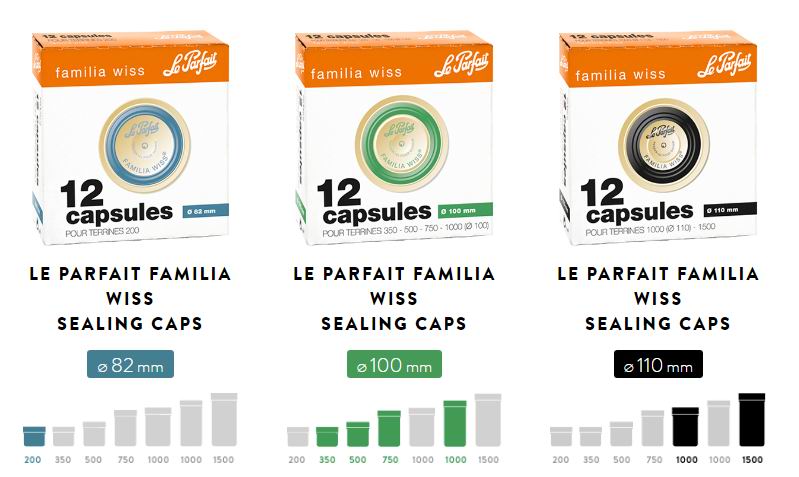
“Capsules” is the French term for “canning sealing lids.”
You can view the full range of Parfait Familia Wiss lids and screw bands here.
The lids for the Familia Wiss jars are made by the Massily Groupe. [3]distributed by their sub-company Conservor SAS. “Nous distribuons les bouchons et obturateurs « joint familial » ou «joint industriel » pour terrines FAMILIA WISS®, dans les diamètres 82, 100 et 110. Toutes nos capsules EURO-TWIST®, EUROCAP® et FAMILIA WISS® sont fabriquées par le Groupe MASSILLY.” Accessed January 2017 at https://www.conservor.fr/nos-produits/le-fer-blanc.html
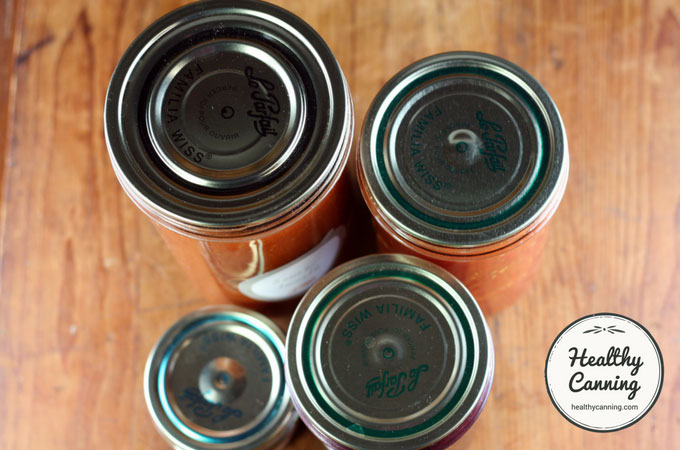
The three sizes of Le Parfait canning lids, seen from above. Top left 110 mm, bottom left 82 mm, to the right two jars with 100 mm lids on them. Note that the largest size, 110 mm, is without a “button” on it.
To be clear, just as with other Mason-type jars today, it is the flat lid that provides the hermetic seal, maintaining the safety of food products that have been properly processed following scientifically-based recommendations from reputable sources for those food items. The solid-centre screw band is for holding the flat lid in place during processing, and, if needed, for refrigerated storage of the preserve after opening: it has no role in the shelf-stable safety of the jar of preserves.
Solid-centre screw bands
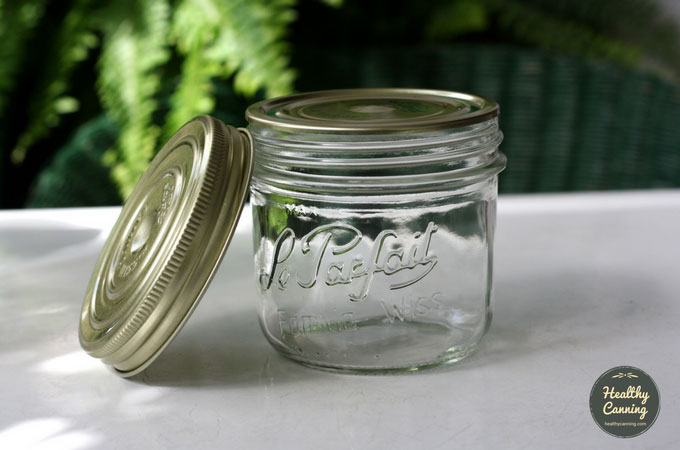
Showing the flat lid and solid-centre screw band.
The solid-centre screw bands serve two purposes.
The first is to hold the lid in place during processing of the jar.
Le Parfait advises that after processing, and after the jar has cooled and sealed, you need to remove the screw band to check the seal on the lid. You would do this in the same way you do all other Mason jar lids: by simply lifting the jar slightly holding it at the rim of the lid.
When you go to store the processed jars away, you may leave the canning ring off — it serves no more purpose. Le Parfait says, “you may choose to screw back the [screw band] or leave off.” [4] https://www.leparfait.co.uk/le-parfait-familia-wiss-terrines.html. Accessed May 2015
(Many reputable sources now recommend leaving the screw bands off for storage.)
The second function of the solid-centre screw band is to act as a storage cap for opened jars in the fridge.
“The full [screw band] means you don’t have to worry about handling the [lid] once your canned goods have been opened and stored in the refrigerator, allowing for easier use and cleaner presentation.” [5] Le Parfait Catalogue 2016. Page 13.
Note though that these metal storage caps have the same weakness as do the white plastic storage caps from other canning suppliers: they don’t provide a completely air-tight seal and if the jar is knocked over in the fridge, liquid contents will leak out.
In French, you may see these solid-centre screw bands referred to as “couvercle à vis ” (“couvercle” means “cover”, “visser” meaning “to screw.”)
Unique lid stabilizing system during processing
Le Parfait lids have one added aspect to help stabilize them more during processing more other Mason jar lids. This added stabilization helps keep the lid’s gasket lined up with the rim of the jar better, and, helps prevent food travelling up out of the jar and onto its rim during processing, thus blocking a seal.
Here’s how they achieved this additional stabilization.
The 82 mm and 100 mm lids
Two of the lid sizes — 82 mm, and 100 mm — have raised (convex) buttons at their centres on the top of the lids. The solid-centre screw bands for these lids have a button in the centre as well, but instead of being raised it is indented (concave) from the top.
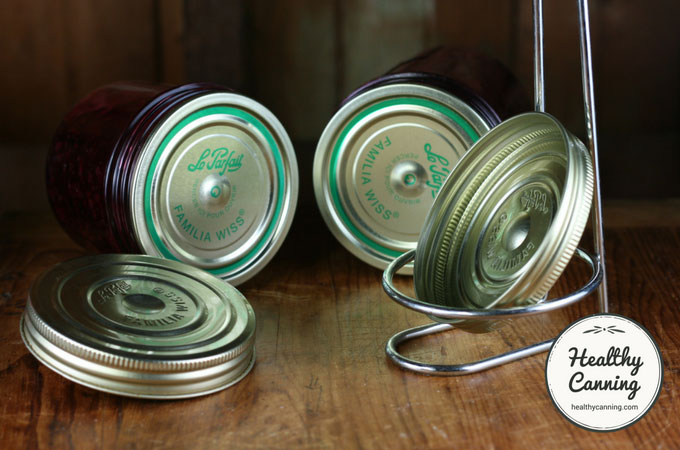
100 mm flat lids with their corresponding solid-center screw bands.
When you put together the flat lid with its raised button, and the solid-centre screw band with its indented button, the indented button from the screw band is going to meet the raised button on the lid.
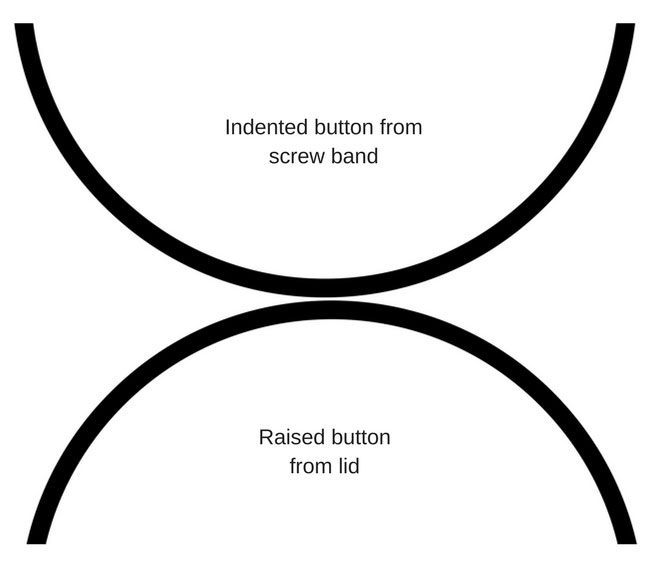
The two ‘buttons’ meet to provide centre stabilization for the lid.
This creates an additional point of stabilization for the lid during processing because the lid’s positioning is secured not just from the sides, but also from the centre. Le Parfait says that relying just on a screw band, screwed perhaps unevenly at times to the glass jar’s threads, can result in a lid being held unevenly or moving unevenly about during processing.
Anyone who’s canned enough will certainly recognize the feeling of wondering if a screw band being screwed onto a jar has actually caught the jar’s threads evenly, or not. And, bear in mind that as air is forced out of Mason jars during heat processing, screw bands do loosen progressively more and more, so the added centre stabilization could help prevent a lid from flopping about as this loosens progresses.
A Le Parfait rep explains,
[The raised buttons] are simply an (intentionally) added enhancement to the design, intended to accept the force from the [solid-centre screw band]’s ‘inverted button’ at the center of the [lid], so that the red sealant ring on the underside of the [lid] has a uniform downward pressure around the rim of the glass jar. In competitor’s designs, the screw band may catch the glass jar’s threads unevenly, holding one side of the [lid] tighter than the opposite side.”
Note that the raised buttons on the flat lid are not there to indicate a seal by getting sucked down from a vacuum. In fact, they won’t for home canners. [6]”They do not have to pull down when the vacuum is created, even though they usually do with strong enough vacuum. Most industry customers (food packers) generate the movement from convex to concave when processing.” Bill Nordby to Randal Oulton. Email on file. 22 December 2016
The 110 mm lids
The very largest lid, 110 cm, has a raised inner ring instead of a button, which serves the same purpose of allowing the solid-centre screw band to hold the lid more steadily in place during processing.
The Le Parfait rep continues,
For the 110mm (largest), if you look it from a side view, the innermost ring is raised higher than the exterior ring (similar to the smaller [screw band’s] ‘buttons’) creating this same uniformity of pressure from the screw [band]. You will note on the [solid-centre screw band for this jar], that the inverted button is actually an inverted ‘ring’ to create a uniform downward force on the raised ring of the [flat lid], away from the jar rim. I think Le Parfait chose the ring on the larger [screw band] vs a button simply to optimize force vs. distance from the jar rim.”
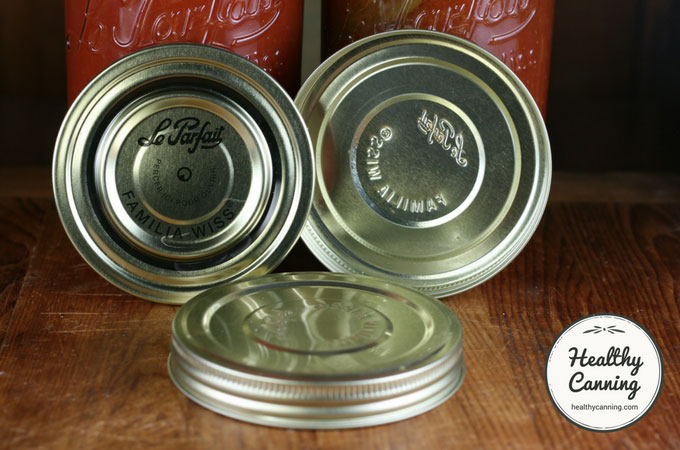
The 110 mm lid with its raised innermost ring, just inside the black circle. And, a view of the solid-centre screw bands that secure the lid during processing by holding the lid stable both at the sides and in the centre.
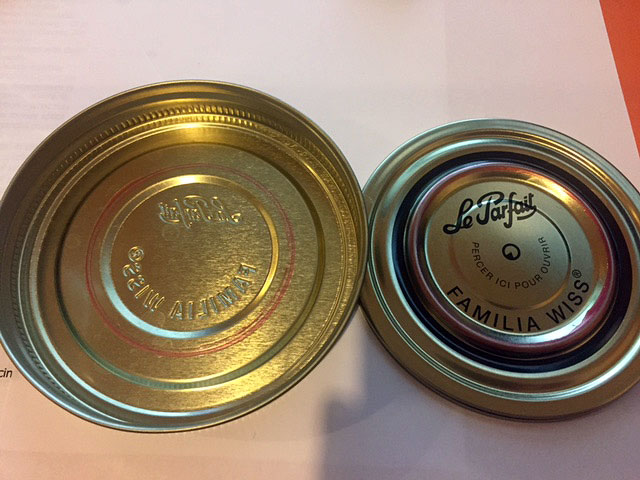
Raised innermost ring on 110 mm lid marked with red lipstick (right), then pressed against solid-center screw band (left) to show how the screw band’s centre helps to provide additional stability to the lid during processing. Courtesy: Bill Nordby, Bannex, 2016.
Opening the lids
Le Parfait suggests a somewhat unique method to open jars sealed with their lids. They sell a tool that looks like a key, with a sharp pointy end on it.
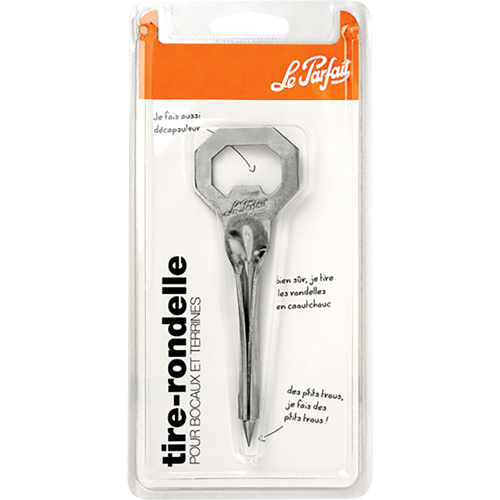
Le Parfait lid piercer
Their directions have you use this pointy end to pierce the centre of the lids on sealed Familia Wiss jars; the resulting hole destroys the vacuum inside the jar and releases the lid for easy removal.
While this may seem a novel way to approach opening a sealed Mason jar, they may not be the first to suggest it. Back in the 1950s, the makers of Atlas Mason jars also advised the same.
It is certainly a good technique for ensuring that people aren’t even tempted to ever re-use their metal canning lids.
Healthy Canning, however, notes that a good old-fashioned bottle opener, as seen below and as is often used in opening Mason jars, also works just fine, as you would expect.
It also seems less dangerous, than having over-zealous associate cooks in the kitchen stabbing away at jars.
Do the solid screw bands affect jar venting during processing?
A minor concern might be whether the solid-centre screw band holding the flat lid in place during processing allows jars to vent as effectively as do screw bands that are hollow in the middle. We note that So Easy to Preserve says,
Some of these jars may have one-piece or other types of lid systems that may or may not offer the same type of air venting and sealing success as the two-piece metal lid system described here.” [7]Andress, Elizabeth L. and Judy A. Harrison. So Easy to Preserve. University of Georgia Cooperative Extension. Bulletin 989. Sixth Edition. 2014. Page 24
Healthy Canning obviously does not have the type of labs that would be required to do industry-standards testing valid for a market of millions of households, but in working with six dozen Le Parfait Familia Wiss jars sent to us for review, we did find the following:
- Every canner knows that it’s very common for Mason jar screw bands to come loose, often very loose, as air is forced out of the jars and looks for a way to escape. The pressure of the air desperate to escape looks for the easiest escape route, and that is often achieved by its unscrewing the screw band a bit. The identical amount of screw band looseness after processing was experienced with Le Parfait’s solid-centre screw bands. That could be interpreted as indicating that the screw bands were loosened by air venting out of the jars in a completely typical fashion. (Le Parfait gives the industry-standard advice not to retighten the screw bands when removing the jars from the canner.)
- Very solid lid seals were achieved on each and every single jar, whether it was processed through pressure-canning, water-bathing, or atmospheric steam canning. We do not have the lab measuring tools available to measure the strength of a vacuum, but even after a year of shelf storage the jars could be swung around forcibly in the air held by the lid edges.
- To be clear, not a single jar seal failure happened despite canning close to 50 different products in 60 jars through pressure-canning, atmospheric steam canning or water-bathing (as required by the tested recipe used.)
In our experience, which again we emphasize obviously cannot be taken to equate lab testing as would be done by USDA home canning experts by any means, we experienced normal venting, and strong seals, even with the solid-centre screw bands.
We got seals that were strong, and that held over time, and, whose integrity we were able to verify easily and beyond any doubt that at any given time.
Le Parfait labels
Le Parfait labels come in square, rectangular and circular shapes of varying sizes, so you can choose the right size for the the right jar — and, depending on how much you want to write on the label. The largest labels enable you to add some usage directions (e.g. “open and heat with 1 tbsp flour.”)
They are high quality labels that don’t tear as you remove them from their sheet, and don’t easily smear when you write on them.
They really add a polished French country home kitchen touch to your home canning.
We noticed as well how easy to was to get the labels off.
Though they withstand condensation well, when the jars are soaked, the labels come easily off, fully intact, rather than gumming up and leaving adhesive gumminess on the jar.
It’s nice that they come off intact, because then it’s job done instead of 5 minutes of scrubbing with a brush to get off the bits still sticking to the jars.
All in all, these are very high quality labels — the best we’ve come across yet — and were an absolute pleasure to work with.
They also offer free labels for printing yourself.
Production of Le Parfait jars
Here is a video of the Le Parfait factory. (There’s an English version of the video, and a French version.)
History of Le Parfait jars
In 1911, Arthur Papon founded a company called “Verreries Mécaniques Champenoises (VMC) (Champagne Mechanical Glassmakers) in Reims in the north-east of France. The company made many home glassware products, such as coloured glass dishes. The Le Parfait preserving jars were just one of its product lines, and in fact were not added until 1930. [8]Gilles Alvès, Isabelle Havard, Bruno Decrock. Verrerie dite Verreries Mécaniques Champenoises, puis Verre Mouvement Création. Région Champagne-Ardenne – Inventaire général. 1995.
At the time that the Le Parfait line of jars was started, its jar-making competitors used names such as “Le Meilleur” (the best), “Le Pratique” (the practical — also made in Reims) [9]Opi & Co. Vent en poupe pour les bocaux rémois ‘le Parfait’ & ‘le Pratique’. Blog entry. Accessed January 2017. https://opiandco.overblog.com/vent-en-poupe-pour-les-bocaux-r%C3%A9mois-le-parfait-%26-le-pratique, “L’Idéale”, or, “Triumph.” [10]Bicard, Daniel. Le Parfait, le bocal qui a mis la conserve à la portée de tous. LSA Commerce & Consommmation. 24 February 2016. Accessed January 2017. https://www.lsa-conso.fr/le-parfait-le-bocal-qui-a-mis-la-conserve-a-la-portee-de-tous,232323
The first jars made were the classic bail-type rounded-shape jars still made, known as the “bocaux” (singular: bocal.)
In the 1940s, the bail-type jars with the straight sides were introduced. They were called the “super” and are also still being made.
In the 1950s, the Familia Wiss line was introduced, in partnership with the Massilly Groupe to make the lids for them. [11]Le Parfait rep Bannex to HealthyCanning. 26 January 2017. Correspondence on file. In fact, VMC and Massilly jointly owned the trademark on the Familia Wiss name. [12]”Massilly S.A. and V M C (Joint Ownership) (France)” UK and EU Registries for trade mark 1001501. Accessed January 2017 at https://uk.trademarkdirect.co.uk/familia-wiss-1001501
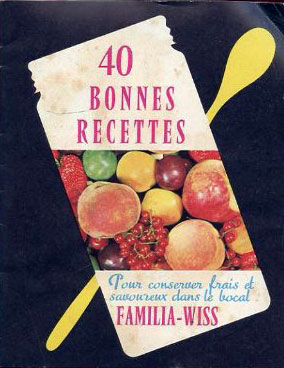
A 1976 recipe booklet for Familia Wiss jars. By 1978, the book had been updated to include 50 recipes.
In 1985, the Boussois-Souchon-Neuvesel (BSN — later Danone) glass works company acquired a 49.9% controlling interest in VMC (it had previously acquired an 11% stake.) The preserving jar production of the two companies was merged, with all production moved to VMC. [13]Chapuis, Yves. Histoire de la verrerie de Givors. 1965-2003. 21 November 2007. Web page, accessed January 2017 https://yves.c.free.fr/givvmc3.html An additional oven was added at the same time to the VMC plant. [14]Gilles Alvès et al. Verrerie dite Verreries Mécaniques Champenoises
With the spread of refrigerators into people’s homes, sales of preserving jars fell in the years from 1960 to the 1980s. Production of many competing jars ceased, but Le Parfait was able to survive as VMC continued to make a diversity of glass products to help even the balance sheet out.
In 2001, VMC was purchased by the American company Owens-Illinois from BSN. In 2004, Owens-Illinois then bought the rest of BSN.
In 2005, Owens-Illinois merged VMC and BSN back together. [15]Ambrosi, Pascal. Owens-Illinois va supprimer 460 emplois en France et en Allemagne. Noilles, France: Les Echos. 5 May 2005. Accessed January 2017. https://www.lesechos.fr/26/05/2005/LesEchos/19421-098-ECH_owens-illinois-va-supprimer-460-emplois-en-france-et-en-allemagne.htm
In the same year, 2005, Le Parfait started its preserving school (“École de la conserve”). [16]Bicard, Daniel. Le Parfait, le bocal qui a mis la conserve à la portée de tous. LSA Commerce & Consommmation. 24 February 2016. Accessed January 2017. https://www.lsa-conso.fr/le-parfait-le-bocal-qui-a-mis-la-conserve-a-la-portee-de-tous,232323
In 2009, the VMC factory in Reims was closed. Production of Le Parfait jars was moved to Puy-Guillaume in Auvergne, where it remains at the time of writing (2017). [17] Charton, Dominique. Owens-Illinois ferme une division des Verreries Mécaniques Champenoises. Noilles, France: Les Echos. 7 May 2009. Accessed January 2017. https://www.lesechos.fr/07/05/2009/LesEchos/20420-084-ECH_owens-illinois-ferme-une-division-des-verreries-mecaniques-champenoises.htm The move south also put production closer to the south-west of France, where most home preserving (75%) in France is done today. [18]Le Parfait rep Bannex to HealthyCanning. 26 January 2017. Correspondence on file.
Review summary
The Familia Wiss jars themselves performed superbly for us in pressure canning, water-bathing and atmospheric steam canning. Every lid sealed on sixty jars, with strong seals remaining after one year. The two-piece lid system meets current USDA recommendations for a lid closure system. In our view, the jars can absolutely be used 100% satisfactorily with tested recipes from reputable sources. The jars are an incredible pleasure to work with owing to their heft, clean lines, and generous mouth sizes.
Le Parfait’s canning jar labels are an absolute pleasure to work with in all ways, and probably the top of the line.
The biggest barrier to the adaptation of the Familia Wiss Mason jars may be their price point. Canners in North America will find the price high; canners outside North America will find the price normal. They are best bought in packs to bring the price down. [19]Commercially, food producers buy them in flats for less than one dollar a jar — about .87€ in 2005 for the half-litres in flats of 1,089. Abbo, Francisco Jose Calvani. Qualité et valorisation des produits du terroir: le cas de la <Fleur d’Aubrac>. Master’s Thesis, Institut Agronomie Méditerranéen de Montpellier. 2005. Page 175. One can hope in time that with greater volume sales in North America the price will come down. (The lid maker, Massilly, actually has a plant in North America, so perhaps lid prices could also come down overtime.)
Healthy Canning suggests very strongly not to use any of the Le Parfait canning recipes on their web site. Use instead some of the over 2,000 tested recipes from reputable sources.
So, it’s a “yes” to Le Parfait’s physical products for their superb quality, but, a “no” to their preserving advice and recipes.
Where to buy
These are purchasing links suggested by Le Parfait America. We are passing them on as a courtesy. On the linked pages, you’ll also see their classic hinged-lid jars. To be clear, this home canning review applied only to the two-piece lid Familia Wiss jars.
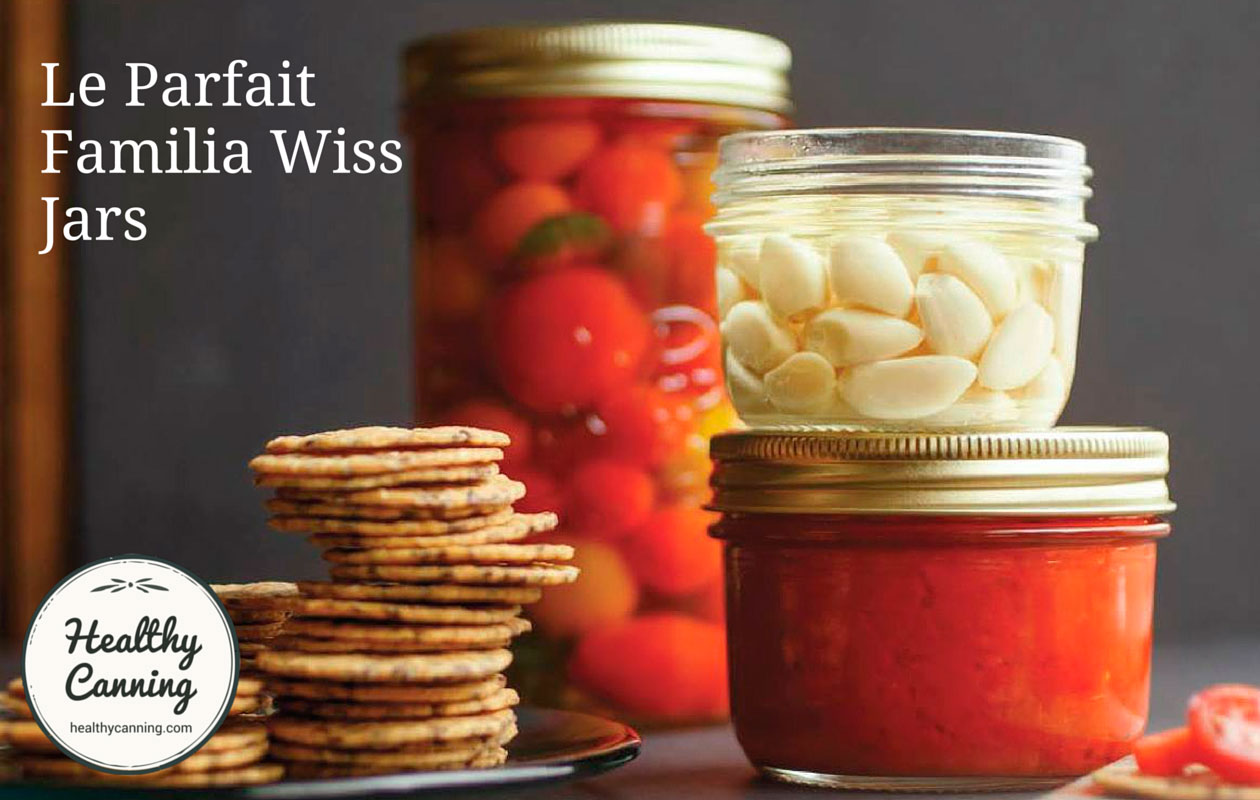
Familia Wiss Jars
References

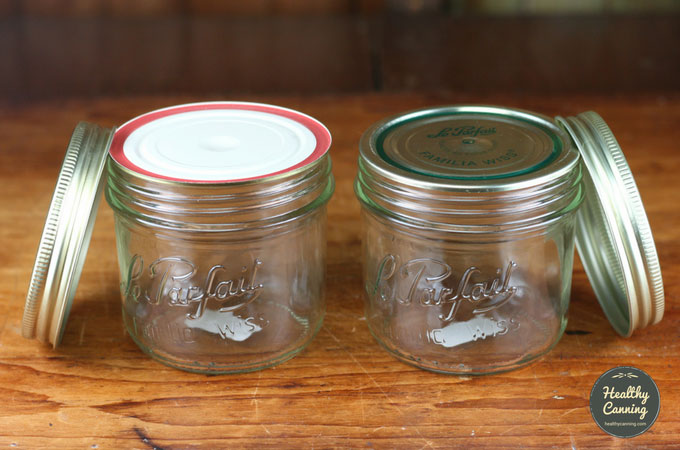
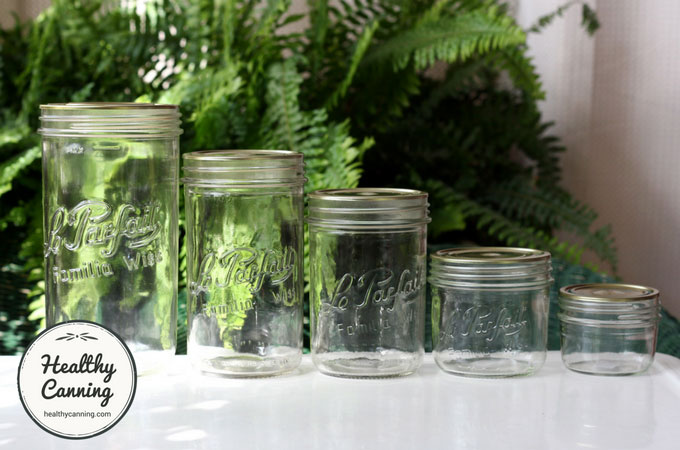
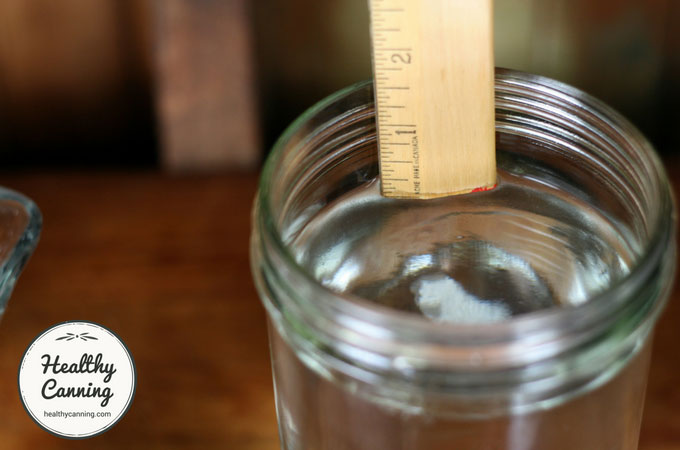
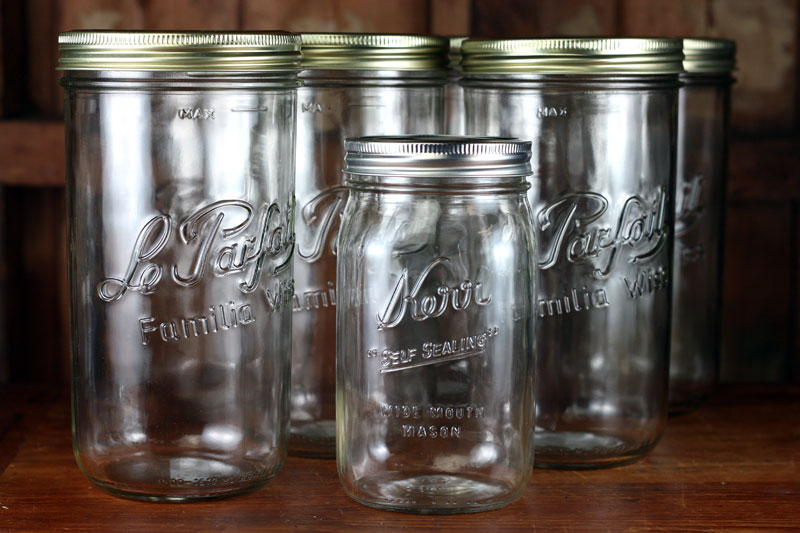
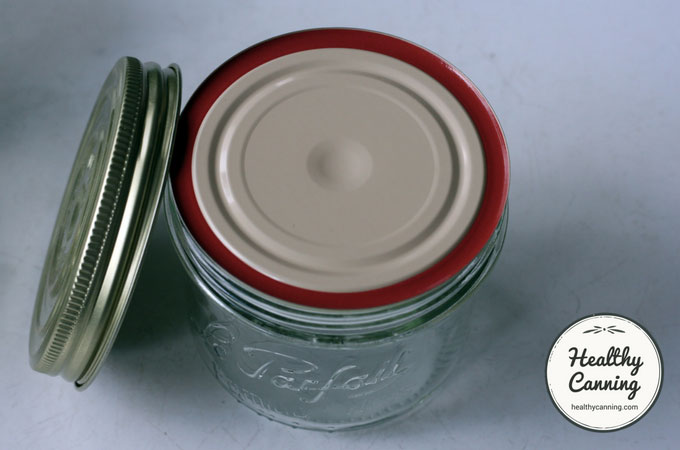
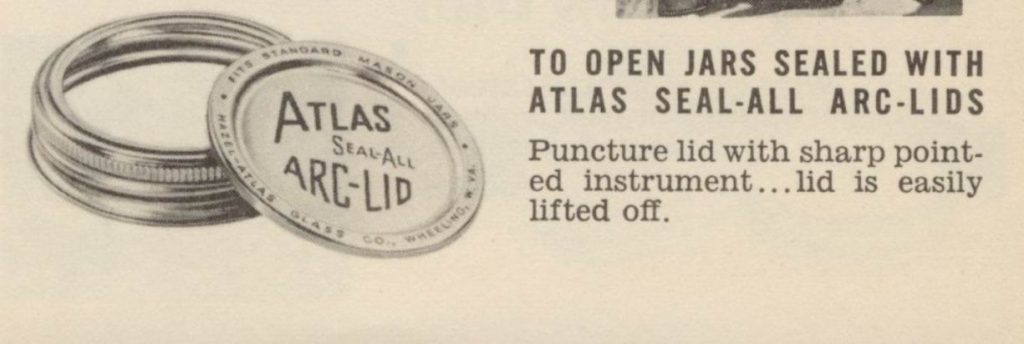
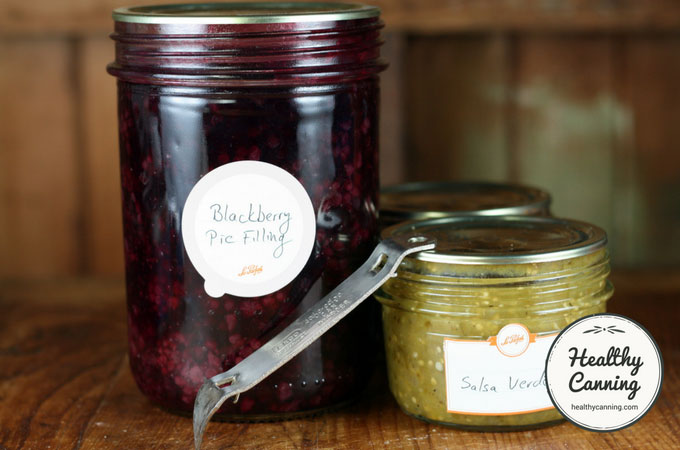

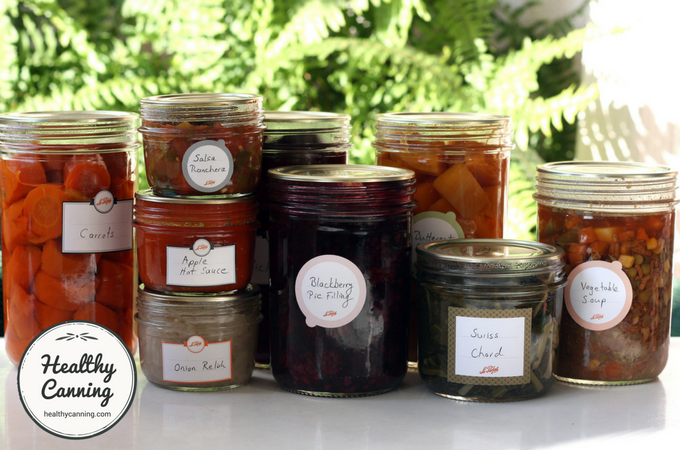
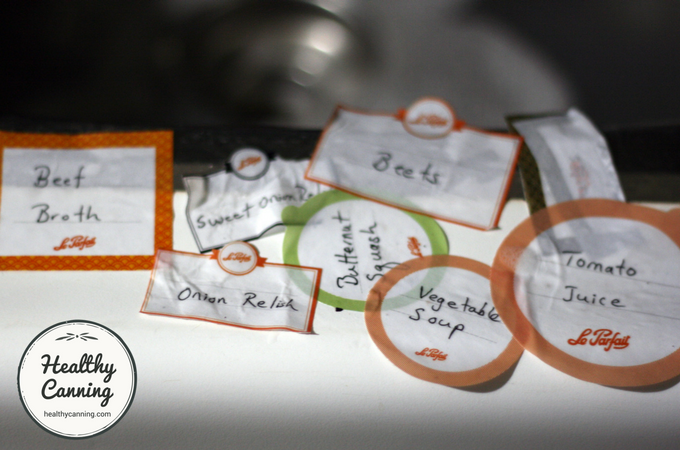
Tracy
Thank you for this very informative review. I am using these jars in France and did not understand how the jars sealed. I could not get good threading from the rings onto the jar, and ended up with water between the ring and the lid. The lid did seem to seal so my fingers are crossed! Any insights would be appreciated.
Alex VI
Thank you for this article. I just canned using these jars and they are a pleasure to work with. The extra wide mouth makes washing them so easy. They’re also heavier and sturdier than kilner/ball.
What confused me a lot was that button in the lid. The seal was rock solid, but I wasn’t sure why the button hadn’t been depressed.
Paul LaFerriere
I read that the center button never depresses when sealed. It is inverted to make sure that the upper solid screw bands tighten and keep the lid in place by lining up once screwed on. Hope this helps. I too am just starting to can and use these and I really like them. Happy Canning!
Margaret Brown
I love Le Parfait!! I store bulk and pantry items as well as leftovers in them instead of using plastic. I’m getting ready to resume canning again after a long absence and was relived to read your positive review of their products. My question is why don’t you recommend using their canning recipes?
Healthy Canning
Their canning recipes are not lab-tested to safety standards and in many instances have you water bath low-acid foods which need to be pressure canned to prevent botulism.
Donald R Leonard Jr
I would pay ANY PREMIUM PRICE for any source that supplies a light blocking 1 qt/ltr Mason Jar with a stainless steel lid and ring.with a separate re-usable silicon rubber seal.
Colin Irwin
The note near the end states: “For shelf-stable home-canning purposes, the USDA currently recommends wire-bail type jars. Consequently, we use Le Parfait’s other jars, their classic bail-type jars, for refrigerator and dry shelf storage only.”
Based on the USDA Complete Guide to Home Canning, 2015 revision should this note actually read “… the USDA *does not* currently recommend wire-bail type jars …”?
Healthy Canning
Thanks for catching that typo Colin — with it, the para doesn’t even make sense! The missing word *against* has now been added. Thanks again.
Linda Shelton
I would like to consider your product for my gift shop in our hotel in Maine. Please send wholesale price list and deliver information. Currently your product is not available in Maine and we are located in a very high tourist area and may like to carry your product exclusively. Thanks so Much. Linda
Healthy Canning
Hi Linda, we’ve asked the Le Parfait people to get in touch with you. You should hear from them shortly.